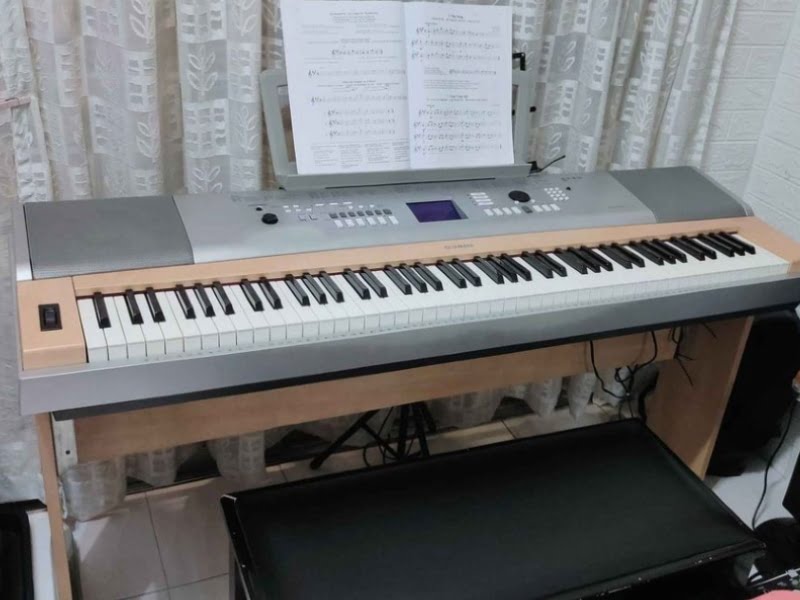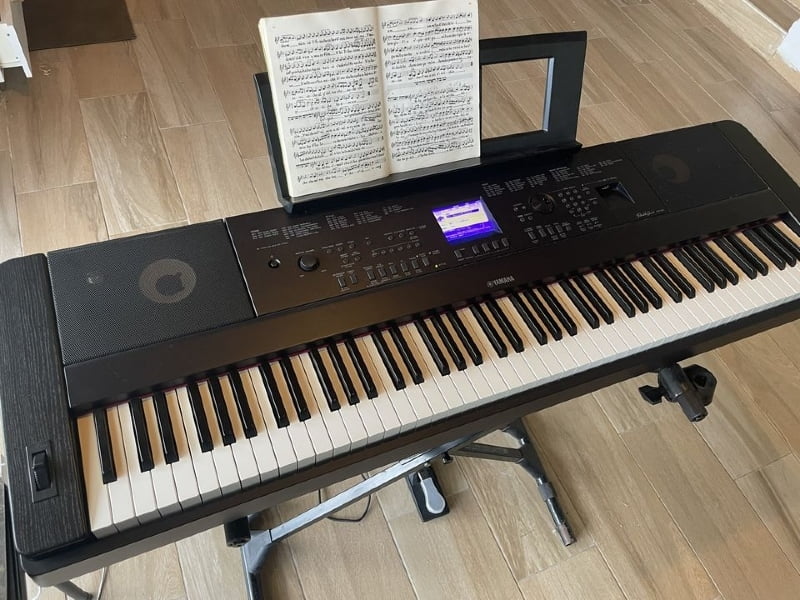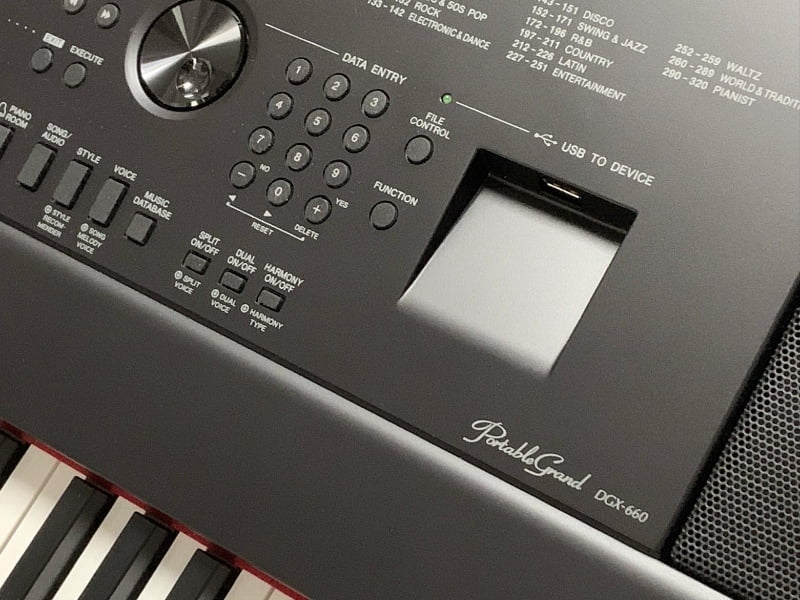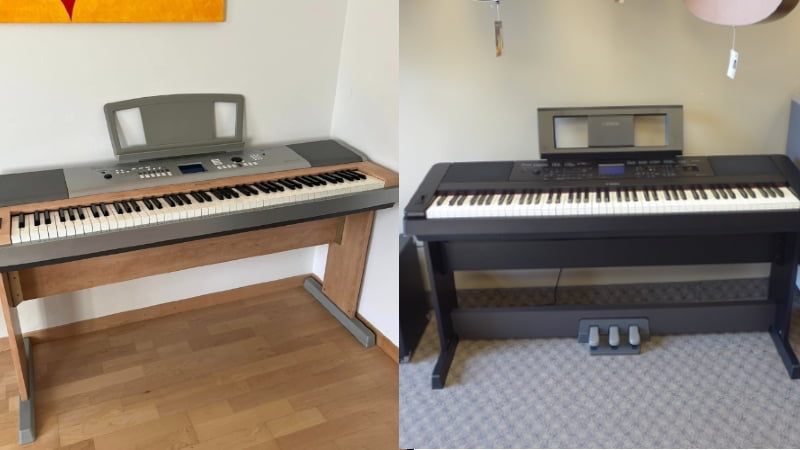The Yamaha DGX line contains a lot of great models; find out the best one for your needs in this Yamaha DGX-620 vs 660 comparison!
I really love the Yamaha DGX collection. It contains some of the best digital pianos that Yamaha offers, along with great value for the money. But if you’re shopping in this collection, you might have difficulty finding the best pick for your needs.
That’s why I’ve created this Yamaha DGX-620 vs 660 comparison.
In this comparison, I take a close look at both of these pianos, which many people consider the best options in the DGX collection. That way, you’ll have a much easier time finding the best model for your needs.
But if you don’t have the time to go through the article, here’s what I learned when conducting this comparison.
The Yamaha DGX-660 is the better option by far. It contains more voices, higher-quality tones, more piano features, and feels much closer to a real acoustic piano. That’s why if you’re ready to buy a good digital piano, I would recommend the DGX-660.
I’ll dive into the finer details of this comparison below. So, keep reading if you want to learn more about both of these models.
Yamaha DGX-620 vs 660: Comparison Chart


Last update on 2025-06-29 / Affiliate links / Images from Amazon Product Advertising API
Yamaha DGX-620 vs 660: A Head-to-Head Comparison
To be honest, when I compared these two pianos, the Yamaha DGX-660 won by a long mile. The DGX-620 is one of the most basic options in the DGX series, so you lack a lot of the features from some of the other models, which is the trade-off you get when you buy a cheaper digital piano.
When reviewing these pianos, I looked at the tone, feel, and piano features of both instruments. And in each category, the DGX-660 won with a score of 3-0. That said, this doesn’t mean that the DGX-620 is a bad piano. In fact, it’s still a great option at its price point.
I get into more details in the section below so you get a clearer picture of who these pianos are for and which one is best for you.
Tone
The winner: Yamaha DGX-660
The tone or the sound of a digital piano is probably one of the instrument’s most important features, which is why this is the first thing I checked out. And unsurprisingly, the DGX-660 easily took the point as it has a massive sound library powered by a top-tier tone engine.

+Tone Generation
The Yamaha DGX-660 comes with the Pure CF Sound Engine. This sound engine is powered by high-quality samples recorded from Yamaha CF Grand Pianos, which are some of the most sought-after acoustic pianos right now. This makes for a crisp and clear piano tone that you won’t be able to find in this price range.
On top of that, it contains hundreds of tones from the XGlite Suite, which contains a lot of unique sounds. Granted, the sounds from this tone generator aren’t as high-quality, but they are definitely great if you need a wide variety of sounds.
The Yamaha DGX-620, on the other hand, only uses a simple sample-based tone generator. It doesn’t use the same samples as the DGX-660, so you don’t have the same realism, clarity, and brightness with this piano.
This was a slight letdown for me as the piano comes from one of my favorite Yamaha product lines. That said, if you’re a beginner looking for a simple practice piano to use at home, the piano sound is still pretty decent. It isn’t ideal for recording or for performances, but it definitely does the job as a home piano.
+Sound Library
One of the things that surprised me with the Yamaha DGX-620 is that it came with 500 voices. Most pianos at this price point only come with a handful of voices, but the DGX-620 really went the extra mile on this one. But again, the sound quality on this piano isn’t the best because Yamaha didn’t load it with the best samples.
So, while you get quantity, you don’t exactly get quality.
The DGX-660, on the other hand, has an even bigger sound library with over 550 sounds. This gives you just about everything you need as a pianist. And while some of the voices could be a bit more realistic, others sounded great and are definitely voices you can use while gigging and playing live.
The DGX-660 easily won the point in the tone comparison because it has a better tone engine and a bigger sound library. So, if you have the extra money, you might want to spend it on the DGX-660 instead of the DGX-620.

Feel
The winner: Yamaha DGX-660
The next feature I looked at was the feel. And since the Yamaha DGX-620 only comes with basic weighted action, it lost to the DGX-660. This model comes with a sophisticated hammer action system and slightly textured keys, allowing it to feel much closer to an acoustic piano.
+Hammer Action
I really liked that the DGX-620 came with weighted keys. Most entry-level pianos don’t even bother to add weight to their keys, so it was a nice touch. However, while the hammer action system of the DGX-620 would be enough for beginners, it isn’t as realistic as most pianists would like it to be.
This is why I rank the DGX-660 over the DGX-620. The DGX-660 comes with the GHS or the Graded Hammer Standard, which is one of the best hammer action systems to come out of Yamaha. This system replicates the small differences in the weight of a piano’s keys, allowing for a much more realistic feel.
On top of that, the black keys on this piano are coated. While they don’t exactly feel like ebony, they come fairly close. The Yamaha DGX-660 isn’t the most realistic feeling digital piano on the market, but it does a much better job than the DGX-620.
Piano Features
The winner: Yamaha DGX-660
The last thing I checked out was the extra piano features. These include polyphony, playing modes, and more. And as expected, the Yamaha DGX-660 easily won this comparison as well. Since this is the more expensive option, it has way more features, allowing for a much more versatile piano.
To start, the DGX-660 comes with 192-note polyphony, which is miles ahead of the 32-note polyphony available on the DGX–620. This allows you to play more notes simultaneously without sacrificing crispness and detail. While the polyphony on the DGX-620 is enough for most beginners, it is significantly lacking when you start playing more advanced pieces and adding the sustain pedal.
And since the DGX-660 has more polyphony, it can handle the various playing modes more often. You can do a lot with the DGX-660, such as blend two voices, split the keyboard, or even creating a twin-piano set up for piano lessons. You can do some of these things on the DGX-620, but since it only has 32-note polyphony, you can’t make the most out of these features.

Yamaha DGX-620 vs 660: The Similarities
These two pianos come from the same product line so you can expect a lot of similarities. To start, they both come with massive sound libraries. This allows you to experiment with different voices to fit various styles of music. And even if the voices on the DGX-660 are higher quality and more varied, you still get more than enough with the DGX-620.
On top of that, both pianos come with relatively good effects set. The effects allow you to take full control over your tone and tweak it according to your needs. So, you get a lot of functionality from both pianos. But since the DGX-660 comes with way more features, I had to dub it the winner.
Quick Rundown of the Yamaha DGX-660
- The Pure CF Sound Engine faithfully reproduces the tone of a meticulously sampled and highly acclaimed Yamaha concert grand piano
- GHS weighted action is heavier in the low register and lighter in the high, just like an acoustic piano
- Score display puts music notation of MIDI songs on the screen, helping you play your favorites by following the bouncing ball
- The Piano room lets you choose from a variety of pianos and acoustic settings to create your own personal piano environment
- The 6 track recorder allows you to capture your performances and song ideas, then add additional layers to spice up your pieces
Last update on 2025-06-29 / Affiliate links / Images from Amazon Product Advertising API
Quick Rundown of the Yamaha DGX-620
No products found.
Product Video
Related Articles to Yamaha Dgx 660
- Yamaha YDP-164 vs DGX-660: Why You Should Go for the DGX-660
- Yamaha DGX-660 vs Roland FP-90: Why the Roland FP-90 Is the Better Pick
- Yamaha DGX-530 vs 660: Why the DGX-660 Is the Better Pick
- Yamaha DGX-505 vs 660: Why the DGX-660 Is the Better Pick
- Yamaha DGX-660 vs DGX-640: A DGX Comparison
- Yamaha DGX-660 vs DGX-630: A DGX Comparison
- Yamaha DGX-660 vs YDP-163: Which Is the Better Piano?
- Yamaha DGX-660 vs Roland Juno DS-88: Which Is the Better Piano?
- Yamaha DGX-660 vs Casio PX-360: Which Is the Better Piano?
- Yamaha DGX-660 vs YDP-144: Which Is the Better Yamaha Piano?
- Yamaha DGX-660 vs Korg Havian 30: Which Is the Better Digital Piano?
- Yamaha DGX-660 vs Casio CGP-700: Which Is the Better Pick?
- Yamaha DGX-660 vs YPG-535: Finding the Best Yamaha Digital Piano
- Yamaha DGX-660 vs P515: Is the P515 Worth the Extra Cost?
- Yamaha DGX-660 vs P-115: Which Yamaha Model Is Better?
- Yamaha DGX-660 vs Casio PX-560: Which Piano Offers More Value For The Money
- Yamaha DGX-660 vs 650: A DGX Comparison
- Korg XE-20 vs Yamaha DGX-660: Finding the Best Digital Piano
- Yamaha P45 Vs DGX-660: A Head-to-Head Comparison
- Yamaha DGX 670 Vs 660: The Distinct Difference In Details You Need To Know About
- Yamaha YDP-103 Vs DGX-660: Which Is The Better Yamaha Piano?
- Casio PX-770 Vs Yamaha DGX-660: Should You Get A Portable Or Console Digital Piano?
- Yamaha P71 vs DGX-660: Can the Amazon Exclusive Beat Out the Premium Model?
- Yamaha P125 vs DGX 660 Comparison: Can the P125 Hold Its Own Against the DGX 660?
References:
- Yamaha DGX-660: https://usa.yamaha.com/products/musical_instruments/pianos/p_series/dgx-660/index.html
- Yamaha DGX-620: https://www.achamilton.co.uk/Yamaha/Keyboards/DGX620.htm
Lulacruza is an electronic folk duo operating at the junction of the hypermodern and the ancient. Our music weaves together hypnotic female singing, South American folk instruments and electronic processing, while channeling pulsating waves from the source of creation.
Lalucruza is also a community where you can connect with other music lovers to collaborate, exchange ideas and share knowledge. A platform for who wants to learns the basics of playing piano, guitar, drum masters’ technique, etc.. is the premise of our website.
